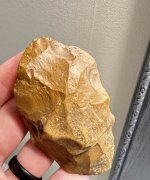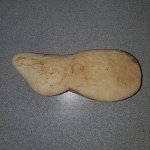kenb
Bronze Member
New Mexico's prehistoric bead trade
Great article on Indian jewelry.
By MARC SIMMONS | The New Mexican
August 17, 2007
A leading expert on prehistoric Southwest jewelry has claimed Indian beads were one of the marvels of Native technology. Even a casual glance at some of the tiny, beautifully made examples recovered by archaeologists would force us to agree.
Ancient trade routes stretching across the Southwest connected important manufacturing and trading centers at which redistribution of goods occurred. In this early-day commerce, beads had high value and were much in demand.
They were made of various materials: conch, olivella and clam shell; tortoise shell; bone; antler; horn; and stone. Much of the shell reached the Pueblos from Texas or California by way of the trading networks.
Shells provided an attractive material and were easy to work. Stone beads, on the other hand, whether crafted of turquoise, jet (found in association with coal) or red rock, required more labor in shaping and drilling.
The Museum of New Mexico has in its collections necklaces composed of several strings of alternating white shell and jet beads, all uniformly sized. To the Anasazi, forebears of the Pueblos, they must have been regarded as spectacular adornments.
In 1921, archaeologist Neil Judd was excavating at the huge ruin of Pueblo Bonito in Chaco Canyon when he stumbled upon “a long-hidden treasure,” in his words.
It was a four-strand necklace of 2,500 superbly formed turquoise beads. Buried with it were two pairs of small beaded loops that were worn on the ears.
Long afterward, Judd would claim the thrill of that discovery never left him.
In addition to necklaces and earrings, the Chaco Anasazi also wore bead bracelets, more so than any other prehistoric Southwesterners. From kiva murals, we know that such bracelets were worn by men, women and children.
Also in Chaco Canyon, an excavation at Chetro Ketl revealed 17,000 turquoise necklace beads sealed inside wall niches of the Great Kiva.
Within Aztec Ruins near Farmington, other archeologists found a string of beads 57 feet long, containing 31,000 disc beads. These were made of slate, however, rather than turquoise.
There were several far-flung turquoise deposits scattered around New Mexico that the Anasazi and their southern neighbors, the Mogollon, might have exploited. But the open pit mines in the Cerrillos Hills south of Santa Fe produced the largest quantity of the most favored blue turquoise.
The Chacoans obtained great quantities of this semiprecious stone, easily identified by its distinctive color as being from the Cerrillos source.
From it, they turned out enormous quantities of turquoise beads, for their own use and for barter with traders coming up from the depths of Mexico.
In 1350 or so, two centuries after the Chaco trading and religious center was abandoned, Keresan-speaking people built a large pueblo two miles east of the Cerrillos mines.
They established ownership over the turquoise deposits, and neighboring pueblos to the west seemed to have recognized their claim. When Spaniards arrived on the scene, they named the village San Marcos.
The inhabitants there seem to have carried on a lively trade in raw turquoise with other tribes. But they must have also been able bead workers themselves.
We should know more about that when the final reports on recent excavations at San Marcos are published. They might well show, as at Chaco, where turquoise beads and other ornaments were produced in workshop areas.
European glass trade beads were brought to the Southwest in quantity by early Spanish expeditions. They served as gifts for the Native Americans or as items for barter.
But they never entirely displaced the Indian beads. To the end of the 19th century, they were still crafted using traditional techniques, such as the simple pump drill to bore a fine hole in each bead.
Using that simple device, a skilled Pueblo craftsman could drill an estimated bead every 10 minutes.
More than a million beads have been recovered from sites in New Mexico and Arizona, and of course, other millions remain lost. Computing 10 minutes per bead, we can get an idea of the staggering amount of work required just for the drilling.
During the 20th century, more sophisticated tools were adopted by the Indians to reduce the time spent at labor. By then New Mexico’s tourism industry was booming, and Indian beads seem fated to remain in style and highly marketable.
Historian Marc Simmons is author of numerous books on New Mexico and the Southwest. His column appears Saturdays.
http://www.santafenewmexican.com/news/66885.html
kenb
Great article on Indian jewelry.
By MARC SIMMONS | The New Mexican
August 17, 2007
A leading expert on prehistoric Southwest jewelry has claimed Indian beads were one of the marvels of Native technology. Even a casual glance at some of the tiny, beautifully made examples recovered by archaeologists would force us to agree.
Ancient trade routes stretching across the Southwest connected important manufacturing and trading centers at which redistribution of goods occurred. In this early-day commerce, beads had high value and were much in demand.
They were made of various materials: conch, olivella and clam shell; tortoise shell; bone; antler; horn; and stone. Much of the shell reached the Pueblos from Texas or California by way of the trading networks.
Shells provided an attractive material and were easy to work. Stone beads, on the other hand, whether crafted of turquoise, jet (found in association with coal) or red rock, required more labor in shaping and drilling.
The Museum of New Mexico has in its collections necklaces composed of several strings of alternating white shell and jet beads, all uniformly sized. To the Anasazi, forebears of the Pueblos, they must have been regarded as spectacular adornments.
In 1921, archaeologist Neil Judd was excavating at the huge ruin of Pueblo Bonito in Chaco Canyon when he stumbled upon “a long-hidden treasure,” in his words.
It was a four-strand necklace of 2,500 superbly formed turquoise beads. Buried with it were two pairs of small beaded loops that were worn on the ears.
Long afterward, Judd would claim the thrill of that discovery never left him.
In addition to necklaces and earrings, the Chaco Anasazi also wore bead bracelets, more so than any other prehistoric Southwesterners. From kiva murals, we know that such bracelets were worn by men, women and children.
Also in Chaco Canyon, an excavation at Chetro Ketl revealed 17,000 turquoise necklace beads sealed inside wall niches of the Great Kiva.
Within Aztec Ruins near Farmington, other archeologists found a string of beads 57 feet long, containing 31,000 disc beads. These were made of slate, however, rather than turquoise.
There were several far-flung turquoise deposits scattered around New Mexico that the Anasazi and their southern neighbors, the Mogollon, might have exploited. But the open pit mines in the Cerrillos Hills south of Santa Fe produced the largest quantity of the most favored blue turquoise.
The Chacoans obtained great quantities of this semiprecious stone, easily identified by its distinctive color as being from the Cerrillos source.
From it, they turned out enormous quantities of turquoise beads, for their own use and for barter with traders coming up from the depths of Mexico.
In 1350 or so, two centuries after the Chaco trading and religious center was abandoned, Keresan-speaking people built a large pueblo two miles east of the Cerrillos mines.
They established ownership over the turquoise deposits, and neighboring pueblos to the west seemed to have recognized their claim. When Spaniards arrived on the scene, they named the village San Marcos.
The inhabitants there seem to have carried on a lively trade in raw turquoise with other tribes. But they must have also been able bead workers themselves.
We should know more about that when the final reports on recent excavations at San Marcos are published. They might well show, as at Chaco, where turquoise beads and other ornaments were produced in workshop areas.
European glass trade beads were brought to the Southwest in quantity by early Spanish expeditions. They served as gifts for the Native Americans or as items for barter.
But they never entirely displaced the Indian beads. To the end of the 19th century, they were still crafted using traditional techniques, such as the simple pump drill to bore a fine hole in each bead.
Using that simple device, a skilled Pueblo craftsman could drill an estimated bead every 10 minutes.
More than a million beads have been recovered from sites in New Mexico and Arizona, and of course, other millions remain lost. Computing 10 minutes per bead, we can get an idea of the staggering amount of work required just for the drilling.
During the 20th century, more sophisticated tools were adopted by the Indians to reduce the time spent at labor. By then New Mexico’s tourism industry was booming, and Indian beads seem fated to remain in style and highly marketable.
Historian Marc Simmons is author of numerous books on New Mexico and the Southwest. His column appears Saturdays.
http://www.santafenewmexican.com/news/66885.html
kenb




